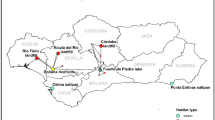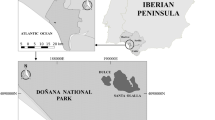Abstract
Waterbirds are known to disperse invertebrate propagules that survive gut passage, but there is very little information about how the probability of dispersal changes at different times of the annual cycle when birds move in different directions, or how it is affected by changes in diet. We studied internal transport of brine shrimp Artemia cysts by migratory waders in the Odiel saltworks in south-west Spain. Viable cysts of parthenogenetic Artemia were abundant in the faeces and regurgitated pellets of redshank Tringa totanus, pellets of spotted redshank T. erythropus, and faeces of black-tailed godwit Limosa limosa during spring and/or autumn migrations in 2001–2002, but were not recorded during winter. Godwits did not produce pellets, and spotted redshank faeces were not sampled. Significant correlations between the number of cysts in a pellet or faecal sample and the proportion of that sample constituted by Artemia adults suggested that most cysts were ingested while in the ovisacs of gravid females. The proportion of cysts destroyed during digestion increased when accompanied by harder food items or grit, and when fewer cysts were ingested. The median number of intact cysts was higher in redshank faeces than in their pellets, but cysts extracted from pellets were more likely to hatch. A higher proportion of redshank pellets contained Artemia cysts in spring than in autumn, but more redshank migrated through the area in autumn. Significantly fewer cysts were recorded in redshank pellets in winter than in spring or autumn. Our results confirm that there is potential for long-distance dispersal of Artemia cysts via waders during both northwards (spring) and southwards (autumn) migrations.

Similar content being viewed by others
References
Abatzopoulos TJ, Beardmore JA, Clegg JS, Sorgeloos P (2002) Artemia: basic and applied biology. Kluwer Academic Publishers, Dordrecht
Amat F, Hontoria F, Ruiz O, Green AJ, Sánchez MI, Figuerola J, Hortas F (2005) The American brine shrimp Artemia franciscana as an exotic invasive species in the Western Mediterranean. Biol Invas 7:37–47
Baxevanis AD, Kappas I, Abatzopoulos TJ (2006) Molecular phylogenetics and asexuality in the brine shrimp Artemia. Mol Phyl Evol 40:724–738
Bohonak AJ, Jenkins DG (2003) Ecological and evolutionary significance of dispersal by freshwater invertebrates. Ecol Lett 6:783–796
Britton RH, Johnson AR (1987) An ecological account of a mediterranean salina: the Salin de Giraud, Camargue (S. France). Biol Cons 42:185–230
Browne RA, Hoopes CW (1990) Genotype diversity and selection in asexual brine shrimp (Artemia). Evol 44:1035–1051
Castro G, Myers JP (1993) Shorebird predation on eggs of horseshoe crabs during spring stopover on Delaware Bay. The Auk 110:927–929
Charalambidou I, Santamaría L, Jansen C, Nolet B (2005) Digestive plasticity in mallard ducks modulates dispersal probabilities of aquatic plants and crustaceans. Funct Ecol 19:513–519
Clausen P, Nolet BA, Fox AD, Klaassen M (2002) Long-distance endozoochorous dispersal of submerged macrophyte seeds by migratory waterbirds in northern Europe-a critical review of possibilities and limitations. Acta Oecologia 23:191–203
Crawley MJ (1993) GLIM for ecologists. Blackwell, Cambridge
Darwin C (1859) On the origin of species by means of natural selection. John Murray, London
del Hoyo J, Elliott A, Sargatal J (eds) (1996) Handbook of the birds of the world, vol 3. Lynx Edicions, Barcelona
de Meester L, Gómez A, Okamura B, Schwenk K (2002) The monopolization hypothesis and the dispersal-gene flow paradox in aquatic organisms. Acta Oecologia 23:121–135
de Vlaming V, Proctor VW (1968) Dispersal of aquatic organisms: viability of seeds recovered from the droppings of captive killdeer and mallard ducks. Am J Bot 55:20–26
Dodson SI, Egger DL (1980) Selective feeding of red phalaropes on zooplankton of arctic ponds. Ecol 61:755–763
Farmer AH, Parent AH (1997) Effects of the landscape on shorebird movements at spring migration stopovers. Condor 99:698–707
Figuerola J, Green AJ (2002a) Dispersal of aquatic organisms by waterbirds: a review of past research and priorities for future studies. Freshw Biol 47:483–494
Figuerola J, Green AJ (2002b) How frequent is external transport of seeds and invertebrate eggs by waterbirds? A study in Doñana, SW Spain. Archi Hydrobiol 155:557–565
Figuerola J, Green AJ, Santamaría L (2002) Comparative dispersal effectiveness of wigeongrass seeds by waterfowl wintering in south-west Spain: quantitative and qualitative aspects. J Ecol 90:989–1001
Figuerola J, Green AJ, Santamaria L (2003) Passive internal transport of aquatic organisms by waterfowl in Donana, south-west Spain. Glob Ecol Biogeogr 12:427–436
Green AJ, Figuerola J (2005) Recent advances in the study of long-distance dispersal of aquatic invertebrates via birds. Divers Distrib 11:149–156
Green AJ, Figuerola J, Sánchez MI (2002) Implications of waterbird ecology for the dispersal of aquatic organisms. Acta Oecologia 23:177–189
Green AJ, Sánchez MI (2006) Passive internal dispersal of insect larvae by migratory birds. Biol Lett 2:55–57
Green AJ, Sánchez MI, Amat F, Figuerola J, Hontoria F, Hortas F (2005) Dispersal of invasive and native brine shrimp Artemia (Anostraca) via waterbirds. Limnol Oceanogr 50:737–742
Havel JE, Shurin JB (2004) Mechanisms, effects, and scales of dispersal in freshwater zooplankton. Limnol Oceanogr 49:1229–1238
Horne FR (1966) The effect of digestive enzymes on the hatchability of Artemia salina eggs. Trans Am Micr Soc 85:271–274
Iverson GC, Warnock SE, Butler RW, Bishop MA, Warnock N (1996) Spring migration of western sandpipers along the Pacific Coast of North America: a telemetry study. Condor 98:10–21
MacDonald GH (1980) The use of Artemia cysts as food by the flamingo (Phoenicopterus ruber roseus) and the shelduck (Tadorna tadorna). In: Persoone G, Sorgeloos P, Roels O, Jaspers E (eds) The brine shrimp Artemia. Ecology, culturing, use in aquaculture, vol 3. Universa Press, pp97–104
Nogales M, Medina FM, Quilis V, González-Rodríguez M (2001) Ecological and biogeographical implications of Yellow-Legged Gulls (Larus cachinnans Pallas) as seed dispersers of Rubia fruticosa Ait. (Rubiaceae) in the Canary Islands. J Biogeog 28:1137–1145
Pennycuick CJ, Battley PF (2003) Burning the engine: a time-marching computation of fat and protein consumption in a 5420-km non-stop flight by great knots, Calidris tenuirostris. Oikos 103:323–332
Proctor VW (1964) Viability of crustacean eggs recovered from ducks. Ecol 45:656–658
Proctor VW, Malone CR, deVlaming VL (1967) Dispersal of aquatic organisms: viability of disseminules recovered from the intestinal tract of captive Killdeer. Ecol 48:672–676
Rice WR (1989) Analyzing tables of statistical tests. Evol 43:223–225
Sánchez MI, Green AJ, Castellanos EM (2005) Seasonal variation in the diet of the redshank Tringa totanus in the Odiel Marshes, south-west Spain: a comparison of faecal and pellet analysis. Bird Study 52:210–216
Sánchez MI, Green AJ, Castellanos EM (2006a) Spatial and temporal fluctuations in use by shorebirds and in availability of chironomid prey in the Odiel saltpans, south-west Spain. Hydrobiologia 567:329–340
Sánchez MI, Green AJ, Castellanos EM (2006b) Internal transport of seeds by migratory waders in the Odiel marshes, south-west Spain: consequences for long-distance dispersal. J Avian Biol 37:201–206
Sánchez MI, Green AJ, Castellanos EM (2006c) Temporal and spatial variation of an aquatic invertebrate community subjected to avian predation at the Odiel salt pans (SW Spain). Arch Hydrobiol 166:199–223
SAS Institute Inc (2000) SAS/STAT ® software, User’s Guide. Cary, NC
StatSoft (1999) Statistica 5.5. Tusla, OK: StatSoft
Stroud DA, Davidson NC, West R, Scott DA, Haanstra L, Thorup O, Ganter B, Delany S (2004) Status of migratory wader populations in Africa and Western Eurasia in the 1990s. Int Wader Stud 15:1–259
Welham CVJ (1994) Flight speeds of migrating birds: a test of maximum range speed predictions from three aerodynamic equations. Behav Ecol 5:1–8
Wetlands International (2002) Waterbird population estimates, 3rd edn. Wetlands international global series No. 12. Wageningen, The Netherlands
Wolf N (2001) Foraging ecology and site selection in Western Sandpipers during their fall migration through southwestern British Columbia. Masters Thesis, Biological Sciences. Simon Fraser University
Wurtsbaugh WA, Maciej Gliwicz Z (2001) Limnological control of brine shrimp population dynamics and cyst production in the Great Salt Lake, Utah. Hydrobiologia 466:119–132
Acknowledgments
This study has been partially funded by the Spanish R&D National Plan (projects BOS2003-02846 and CGL2004-03719). The first author was supported by a Ph.D. grant from the Ministerio de Ciencia y Tecnología and an I3P postgraduate grant from the Consejo Superior de Investigaciones Científicas. The Consejería de Medio Ambiente, Junta de Andalucía and Aragonesas Industrias y Energía S.A. provided permission to work in the saltworks. J.C. Rubio provided logistical support and advice. J. Figuerola and anonymous referees provided valuable comments on the manuscript.
Author information
Authors and Affiliations
Corresponding author
Additional information
Communicated by S.A. Poulet, Roscoff.
Rights and permissions
About this article
Cite this article
Sánchez, M.I., Green, A.J., Amat, F. et al. Transport of brine shrimps via the digestive system of migratory waders: dispersal probabilities depend on diet and season. Mar Biol 151, 1407–1415 (2007). https://doi.org/10.1007/s00227-006-0577-9
Received:
Accepted:
Published:
Issue Date:
DOI: https://doi.org/10.1007/s00227-006-0577-9




